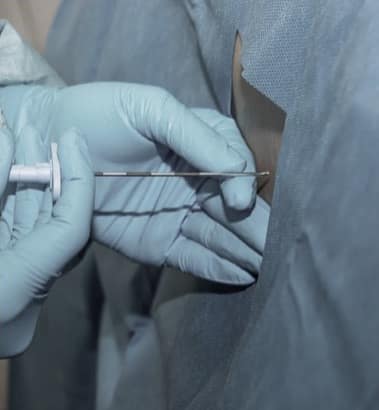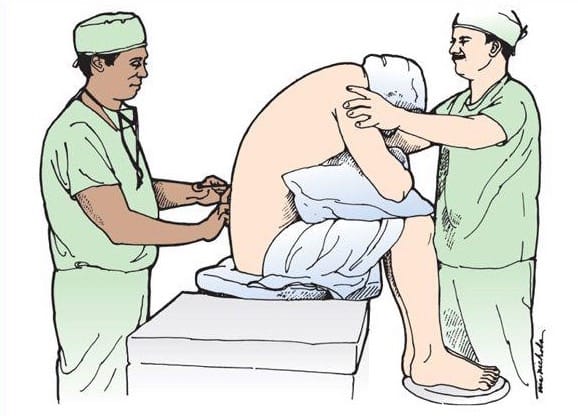Epidural Anaesthesia
What is an epidural anaesthetic?
An epidural is a procedure where an anaesthetic (a medicine that gives either partial or total loss of sensation) is injected into the small space in your back near your spinal cord called ‘the epidural space’. The medicine works by blocking the pain signals from reaching your brain. A fine plastic tube is inserted through an epidural needle (the needle is removed after the tubing is in place). The fine plastic tube is taped onto your back and medicines can be given through this fine tube as long as you require pain relief.
The epidural can be inserted while you are sitting on the side of the bed bending over from the waist or while lying on your side with your knees bent up. This can be uncomfortable during contractions but it is important to stay as still as possible while the anaesthetist is inserting the epidural needle. This anaesthetic takes 15–30 minutes to work. Epidurals are an effective way of making childbirth more comfortable, not every patient can have an epidural. Problems with blood clotting, infection and previous major back surgery may mean that you need a different pain relief option. After an epidural, you will have altered sensation from the waist down. How much you can move your legs after an epidural will depend on the type and dose of local anaesthetic used. A very thin tube will be left in your back so the anaesthetic can be topped up. The tube will be removed when the anaesthetic is no longer required.

What are some advantages of an epidural anaesthetic?
- Effective form of continuous pain relief, especially for childbirth contraction pains
- You can be awake and participate in your baby’s birth
- Requires less medicines than other forms of pain relief
- Does not make you sleepy
- If needed, a stronger epidural can be used as the anaesthetic for caesarean sections or forceps delivery. It is important to understand that while you will be pain free during the operation, you may feel strange pressure sensations
- This avoids a general anaesthetic, where you are in a very deep sleep and recovery time is longer.
What are some disadvantages of an epidural anaesthetic:
- A ‘drip’ (IV fluid) is always put into your vein before the epidural is inserted.
- You will need to be monitored for complications from the epidural, and this might limit your mobility.
- Once the epidural is in place it is very important to understand that you might not be able to walk easily.
- Co-ordinating contractions can be more difficult with an epidural.
- Sometimes, epidurals can fail. In this case, it can either be re-inserted or another form of labour analgesia can be chosen.
What happens during the procedure?
Before the procedure commences, a ‘drip’ (also known as a cannula, intravenous fluids or IV) is always put into one of your veins, usually in your hand or lower arm. You will normally have the epidural injection into your back either sitting, or lying on your side, on the trolley or operating table. The anaesthetist and the team will explain what they want you to do. Just like an operation, the injections are done in a very clean (sterile) way. Local anaesthetic is given into the skin to reduce the pain of the epidural needle.
When the anaesthetist is inserting the epidural needle, they will ask you to stay as still as possible and to tell them if you feel any discomfort, tingling or shock sensations. It can take more than one attempt to get the needle in the right place. If you find this difficult, tell your anaesthetist as there are things they can do to help, including switching to a different kind of anaesthetic. A thin catheter will be inserted into your spine through the needle and medication will be injected into this catheter.
You may notice a warm tingling sensation as the epidural anaesthetic starts to take effect. While you will be pain free during labour and delivery, you may feel movement and pressure sensations around your pelvis.

What are the risks of epidural anaesthesia?
Common risks and complications:
- Failure of the epidural
- Nausea, vomiting, itching and shivering
- Low blood pressure: this can make you feel faint, dizzy or sick
- Problems in passing urine: you may require a catheter to be placed in your bladder
- Pain during the injection: immediately tell your anaesthetist if you feel pain in places other than where the needle is. The pain might be in your legs or bottom and might be due to the needle touching a nerve
- Headache and/or backache
- Pain, bruising and/or bleeding at the injection site
- Prolonged numbness or tingling.
Uncommon risks and complications:
- Severe headache: Please inform your doctor immediately if you have a severe and persistent headache after spinal anaesthesia
- Temporary nerve damage:
temporary loss of sensation, pins and needles and sometimes muscle weakness in the lower body - Allergic reaction to the medication, requiring further treatment
- Existing medical problems getting worse
Rare risks and complications:
- Permanent nerve damage with possible paralysis
- Severe breathing difficulty: the block may go higher than planned and affect breathing by paralyzing the breathing muscles
- Infection around injection site which may cause meningitis and/ or epidural abscess, requiring antibiotics and further treatment
- Blood clot with spinal cord damage
- Serious allergic reaction or shock to the medication, requiring further treatment
- Equipment failure (e.g. breakage of needles or catheters possibly requiring surgery to remove them)
- Local anaesthetic toxicity, requiring further medication and treatment
- Seizures may occur, requiring further medication and treatment
- Heart attack or stroke could occur due to the strain on the heart
- Death and cardiac arrest as a result of this anaesthesia are rare.
NB: PLEASE INFORM YOUR ANAESTHETIST IF YOU ARE ON BLOOD THINNING MEDICATION, HAVE A BLEEDING DISORDER OR HAVE ANY FORM OF NEUROLOGICAL DISEASE.